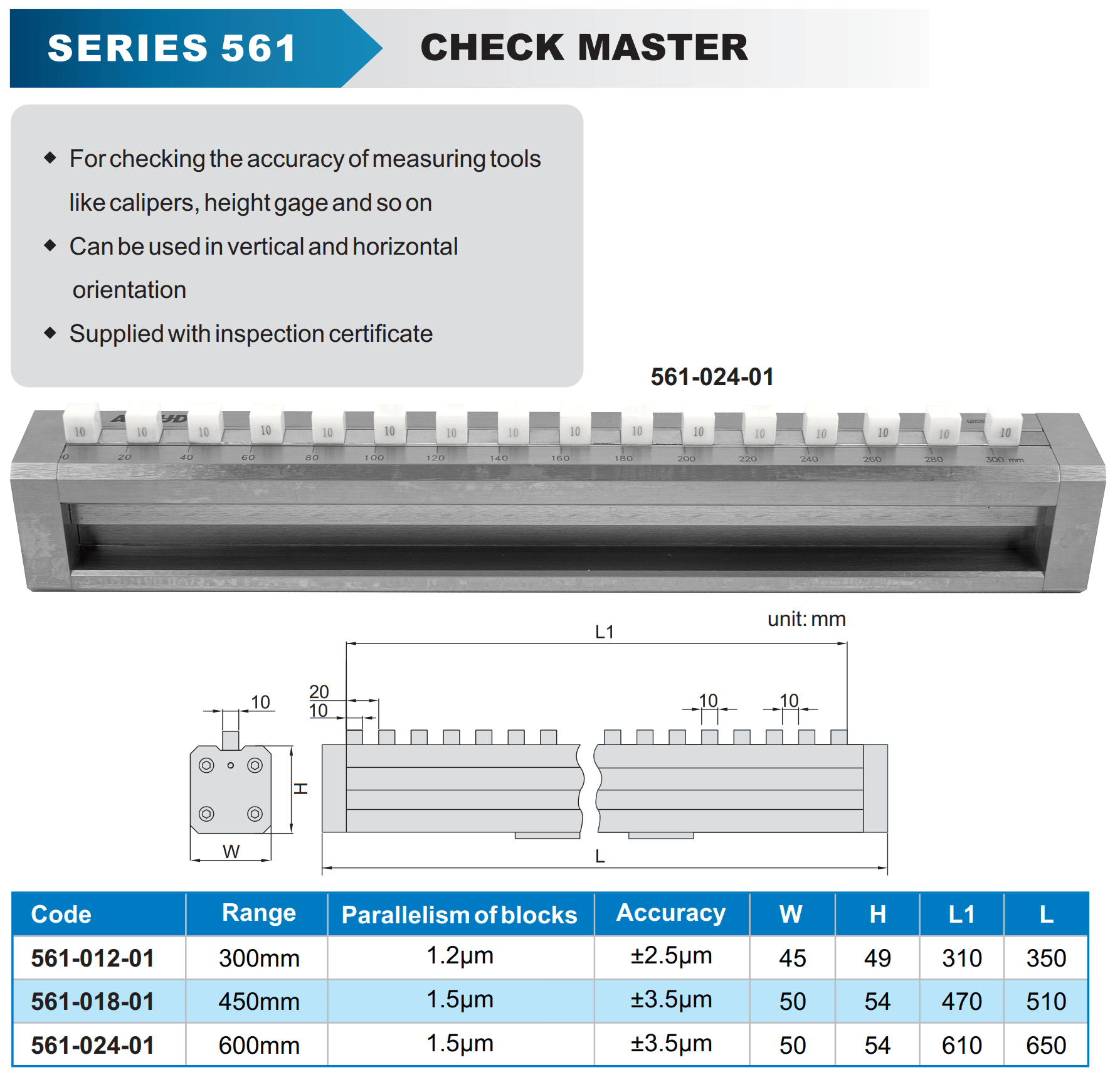





- Stock: In Stock
- Model: AC561-012-01
- Weight: 5.44kg
- Dimensions: 158.00cm x 446.00cm x 446.00cm
- SKU: AC561-012-01
- UPC: 6009515871888
- MPN: 1
More from this brand
SERIES 561
A check master (or gauge block check master) is a precision reference tool designed specifically for verifying and calibrating the accuracy of various measuring instruments such as calipers, height gauges, micrometers, dial indicators, and other dimensional measuring tools. By using a check master, you can ensure that your measurement instruments are providing accurate and consistent readings over time, which is essential for maintaining quality control in manufacturing, machining, and other industries.
A check master is a valuable tool for anyone involved in precision measurement, ensuring that their instruments are accurate, reliable, and calibrated according to recognized standards.
Benefits of Using a Check Master:
- Ensures Accuracy: Regular checks with a check master help maintain the accuracy of measuring tools, reducing errors in production or inspection processes.
- Minimizes Downtime: Quick verification and calibration of tools using a check master help to avoid lengthy downtime due to faulty measurements or tool readjustment.
- Cost-Effective: By identifying out-of-tolerance measuring tools early, costly rework or scrapping of parts can be avoided.
- Easy to Use: The design of a check master allows for simple, quick checks without the need for extensive training or complex setups.
Applications of a Check Master:
-
Calipers:
- Check masters allow calipers to be calibrated by comparing the displayed measurements against the known step heights or blocks of the check master.
-
Height Gauges:
- Height gauges are checked by placing the gauge’s measuring probe on the different reference surfaces of the check master, ensuring that the gauge is accurate throughout its measuring range.
-
Micrometers:
- Check masters can be used to calibrate micrometers, ensuring that the micrometer reads correctly at specific measurement points.
-
Dial Indicators:
- A check master can also be used to verify the accuracy of dial indicators by comparing their readings against the reference surfaces or dimensions provided by the check master.
-
Precision Measurement in Industry:
- Check masters are critical in industries like aerospace, automotive, manufacturing, and precision engineering, where maintaining tight tolerances and ensuring accurate measurements are essential.
Key Features of a Check Master:
-
Precision Reference Standards:
- The check master includes high-precision reference blocks or surfaces that serve as a known standard against which measuring tools can be checked.
- The reference values are certified and traceable to international measurement standards (such as ISO), ensuring the utmost accuracy.
-
Material and Durability:
- Made from durable, high-quality materials like hardened steel or carbide, the check master ensures long-term stability and wear resistance.
- Some models use ceramic or chromium carbide blocks for enhanced resistance to wear and corrosion, particularly in harsh environments.
-
Versatility:
- Check masters are designed to be used with a wide variety of measuring
tools, including:
- Calipers (digital, dial, and vernier)
- Height gauges
- Micrometers
- Dial indicators
- Bore gauges
- The tool typically comes with multiple reference points or steps at fixed intervals, allowing the user to check the accuracy of different ranges of the measuring instrument.
- Check masters are designed to be used with a wide variety of measuring
tools, including:
-
Accuracy Verification:
- The check master provides certified reference dimensions for verifying the accuracy of both the upper and lower measuring limits of instruments.
- Calibration can be done at multiple points along the range of the measuring tool, allowing users to detect potential inaccuracies or deviations over the full measurement range.
-
Calibration Process:
- To verify the accuracy of a measuring tool, the instrument is compared directly against the certified dimensions of the check master.
- For example, when calibrating a caliper, the caliper jaws can be opened to the exact reference lengths provided by the check master, and the reading on the caliper is checked against the actual known value.
-
Built-in Steps and Heights:
- Many check masters are designed with stepped surfaces or multiple stacked blocks of different heights. These provide several preset reference points, such as 5 mm, 10 mm, 15 mm, etc., or the equivalent in inches for imperial tools.
- These stepped blocks allow users to check different ranges of the measuring tool in one device without needing multiple separate gauge blocks.
-
Storage and Handling:
- Check masters are typically stored in protective cases with individual compartments to ensure the reference surfaces are not damaged or contaminated.
- To maintain accuracy, the check master should be handled with care, using gloves to avoid transferring oils or debris that could affect the precision.
-
Types of Check Masters:
- Single-Step Check Masters: These have one fixed height or dimension and are used for basic checks or spot calibration.
- Multi-Step Check Masters: These offer multiple preset heights or dimensions in one tool, making them versatile for checking instruments with a wide range of measurement capabilities.
- Calibration Kits: These often contain multiple blocks or steps to calibrate tools across a broad range of dimensions.

































































